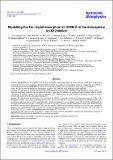Por favor, use este identificador para citar o enlazar a este item:
http://hdl.handle.net/10261/208942COMPARTIR / EXPORTAR:
 SHARE SHARE
 CORE
BASE CORE
BASE
|
|
| Visualizar otros formatos: MARC | Dublin Core | RDF | ORE | MODS | METS | DIDL | DATACITE | |

| Título: | Modelling the He i triplet absorption at 10 830 A in the atmosphere of HD 209458 b |
Autor: | Lampón, M.; López-Puertas, Manuel CSIC ORCID; Lara, Luisa María CSIC ORCID; Sánchez López, Alejandro; Salz, M.; Czesla, S.; Sanz-Forcada, J. CSIC ORCID; Molaverdikhani, K.; Alonso-Floriano, F. Javier ; Nortmann, L.; Caballero, J. A. CSIC ORCID; Bauer, FF ; Pallé, Enric; Montes, D.; Quirrenbach, Andreas; Nagel, Evangelos; Ribas, Ignasi ; Reiners, Ansgar; Amado, Pedro J. CSIC ORCID | Palabras clave: | Planets and satellites: atmospheres Planets and satellites: gaseous planets Planets and satellites: individual: HD 209458 b |
Fecha de publicación: | 2020 | Editor: | EDP Sciences | Citación: | Astronomy and Astrophysics - Les Ulis 636: A13 (2020) | Resumen: | Context. HD 209458 b is an exoplanet with an upper atmosphere undergoing blow-off escape that has mainly been studied using measurements of the Lyα absorption. Recently, high-resolution measurements of absorption in the He I triplet line at 10 830 A of several exoplanets (including HD 209458 b) have been reported, creating a new opportunity to probe escaping atmospheres. Aims. We aim to better understand the atmospheric regions of HD 209458 b from where the escape originates. Methods. We developed a 1D hydrodynamic model with spherical symmetry for the HD 209458 b thermosphere coupled with a non-local thermodynamic model for the population of the He I triplet state. In addition, we performed high-resolution radiative transfer calculations of synthetic spectra for the helium triplet lines and compared them with the measured absorption spectrum in order to retrieve information about the atmospheric parameters. Results. We find that the measured spectrum constrains the [H]/[H+] transition altitude occurring in the range of 1.2 RP-1.9 RP. Hydrogen is almost fully ionised at altitudes above 2.9 RP. We also find that the X-ray and extreme ultraviolet absorption takes place at effective radii from 1.16 to 1.30 RP, and that the He I triplet peak density occurs at altitudes from 1.04 to 1.60 RP. Additionally, the averaged mean molecular weight is confined to the 0.61-0.73 g mole-1 interval, and the thermospheric H/He ratio should be larger than 90/10, and most likely approximately 98/2. We also provide a one-to-one relationship between mass-loss rate and temperature. Based on the energy-limited escape approach and assuming heating efficiencies of 0.1-0.2, we find a mass-loss rate in the range of (0.42-1.00) ×1011 g s-1 and a corresponding temperature range of 7125-8125 K. Conclusions. The analysis of the measured He I triplet absorption spectrum significantly constrains the thermospheric structure of HD 209458 b and advances our knowledge of its escaping atmosphere. © ESO 2020. | Versión del editor: | http://dx.doi.org/10.1051/0004-6361/201937175 | URI: | http://hdl.handle.net/10261/208942 | DOI: | 10.1051/0004-6361/201937175 | ISSN: | 0004-6361 |
| Aparece en las colecciones: | (CAB) Artículos (IAA) Artículos |
Ficheros en este ítem:
| Fichero | Descripción | Tamaño | Formato | |
|---|---|---|---|---|
| IAA_2019aa37175-19.pdf | 2,97 MB | Adobe PDF |  Visualizar/Abrir |
CORE Recommender
SCOPUSTM
Citations
51
checked on 21-abr-2024
WEB OF SCIENCETM
Citations
16
checked on 26-feb-2024
Page view(s)
178
checked on 23-abr-2024
Download(s)
124
checked on 23-abr-2024
Google ScholarTM
Check
Altmetric
Altmetric
NOTA: Los ítems de Digital.CSIC están protegidos por copyright, con todos los derechos reservados, a menos que se indique lo contrario.
